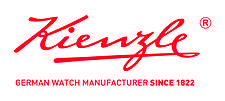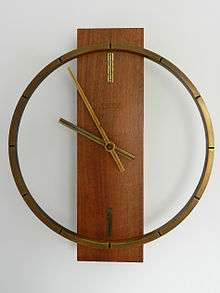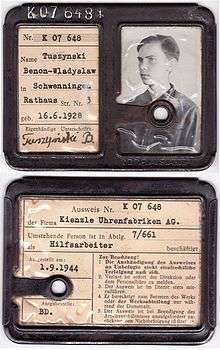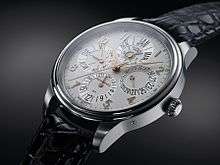Kienzle Uhren
KIENZLE Uhren GmbH is Germany's oldest watchmakers. Founded in 1822 in Schwenningen, the company headquarters has been in Hamburg since 2002.
 | |
| Industry | Time measuring devices |
|---|---|
| Founded | 1822 |
| Headquarters | |
Key people | Stephan W. Kruse-Thamer (CEO) |
| Products | watches |
| Website | www.kienzleuhren.de |
History


In 1883 Jakob Kienzle married into the Schlenker family and henceforward he contributed to the expansion of the company. In 1899, 162,000 watches and alarm clocks were made per annum. The name of the company was changed to Schlenker & Kienzle.
From 1894 onwards the weight and the cost of alarm clocks and wall clocks was significantly reduced by the introduction of the "American System" with standardised individual components and perforated plates. This process was highly innovative at that time. In 1897 Jakob Kienzle became the sole owner, with the name of the company later being changed to Kienzle. Watch production was continuously extended and modernised, and international activities expanded. In the following years branches in Milan, Paris and London were established.[1]
In 1902 Kienzle launched the time stamp clock on the market, followed by inexpensive pocket watches, travelling clocks and wristwatches for ladies. The first clocks for automobiles were also made at that time. The so-called "Strapazier-Armbanduhr" was presented in 1931. This watch is extremely resilient because of its special construction. The watch model becomes a popular product, with 25 million examples sold.[2]
At the end of the 1930s, Kienzle started the manufacture of two table clocks in the upper price segment: the Zodiac Clock and the World Time Clock. After the Second World War Kienzle continued production with established articles and new products like a parking meter equipped with the latest technology.
During the Second World War, the company augmented the employed work force with slave labour from Poland and other conquered areas. The factory produced and supplied a range of timing instruments and watches for German and Axis armed forces. These included chronograph 8-day cockpit clocks for Messerschmidt and Heinkel aircraft[3] as well as wrist and pocket watches for general purchase, and for the Wehrmacht and the Luftwaffe.
In 1956 the so-called "Volksautomatik" was introduced to the market. Energy is provided by a rotor that winds in both directions and instead of steel pins the lever is fitted with ruby pins.[4]
In the 1960s, Kienzle produced dashboard clocks for Rolls-Royce and Bentley. Both Series 1 Silver Shadow, and Bentley T models were fitted with a Kienzle clocks.[5]
In the 1960s and 1970s Kienzle became a market leader in Germany. In 1972 the first solar watch, "Heliomat", was produced as well as the first quartz movements.[6] In the following years Kienzle was the first company to present a quartz travel alarm clock.[7]
In 1986 Kienzle developed the first solar watch with light conditions and a polycrystalline solar element. In the early 1990s, Kienzle developed the most water-resistant watch in the world which was resistant up to 12,000 metres. They also developed the world's first radio-controlled "atomic" alarm clock with an analogue alarm setting.
In 1996 a new radio-controlled movement was perfected: the smallest dual-motor, radio-controlled movement with the fastest setting system. This movement corrects to the right time within just five minutes.[8]
Present
In 1997 Kienzle was taken over by the Highway Holdings Group. But only five years later in 2002, Kienzle returned to Germany with the establishment of Kienzle AG. The company employs over 450 workers in its new factory. Since that time, the headquarters is located in Hamburg and Kienzle returns to former levels of success.[9] The company purchases the worldwide brand and distribution rights and began with the development and fabrication of three new watch collections in different price segments.[10]
In 2008 Kienzle moved into the current headquarters, a time honored merchant's house in Hamburg-Harvestehude, which perfectly represents the company and its values: quality, tradition and innovation.[11][12]
In the future Kienzle, plans to extend to a medium-sized lifestyle brand. Kienzle Optik is the first expansion segment to be launched on the market. However, watches and clocks will remain the core area of the brand.[10]
Watch collection

The watch collection of the company includes numerous models in different price segments.[13]
At the entry price level are the "Kienzle Klassik" models, with a variety of case shapes and dials, including pocket watch styles.[14]
The mid-price segment is occupied by the "Kienzle 1822" models.[11] The name "Kienzle 1822" is based on the founding year of the company.[15]
The "Edition Jacob Kienzle" consists of eight traditional styles of watch with different complications.[16][17]
The "Edition Color" has leather straps which are colored on the inside.[11] Most of the models are "Made in Germany".[18]
Sponsoring
Kienzle regularly sponsors different projects, but increasingly focuses on sport. In 1992 Katja Seizinger was supported doing the Olympic Games.[19]
Kienzle sponsored the SG Flensburg-Handewitt. From the season 2009/2010 Kienzle will be official partner of the Hamburg sports club and will support the Bundesliga-watch in the arena.
Social projects are important to the company. E.g., Kienzle supports the Hamburg Leuchtfeuer Hospiz which is under the patronage of Hamburg mayor Ole von Beust.[20][21]
See also
References
- Lehmhaus, Schmidt and Welchering, p. 12
- Lehmhaus, Schmidt and Welchering, p. 14
- "WWII German clocks". www.historictimekeepers.com. Retrieved 7 November 2016.
- Lehmhaus, Schmidt and Welchering, pp. 19 and 21
- "KIENZLE CLOCK (With white seconds hand) (UD19360SXR)". www.flyingspares.com. Retrieved 7 November 2016.
- Lehmhaus, Schmidt and Welchering, p. 32
- Lehmhaus, Schmidt and Welchering, p. 21
- Lehmhaus, Schmidt and Welchering, pp. 19ff
- Lehmhaus, Schmidt and Welchering, p. 35
- Lehmhaus, Schmidt and Welchering, p. 36
- Armband Uhren. Heel, Königswinter 2009. ISSN 1431-3677. p. 55
- Chronos Edition: Uhren 2008. Ulm, Ebner 2007. ISBN 978-3-87188-089-6 und 978-3-87188-091-9. Seite 84.
- Lehmhaus, Schmidt and Welchering, p. 37
- Lehmhaus, Schmidt and Welchering, p 153/155
- Lehmhaus, Schmidt and Welchering, pp. 145,147,149
- Chronos Edition: Uhren 2009. Ulm, Ebner 2008. ISBN 978-3-87188-109-1 and 978-3-87188-104-6. p. 80
- Lehmhaus, Schmidt and Welchering, p. 143
- Lehmhaus, Schmidt and Welchering, p. 147
- Lehmhaus, Schmidt and Welchering, pp. 91/93
- Presseecho: HSV-Presseservice: KIENZLE Uhren GmbH wird neuer offizieller Uhrenpartner des HSV. 20 April 2009. http://www.presseecho.de/Sport/NA3731390250.htm%5B%5D
- "Kienzle: New partner of HSV". WatchTime. Retrieved 21 May 2015.
- General
- Jan Lehmhaus, Tim Stefan Schmidt and Peter Welchering: KIENZLE. Bd. 1. Zürich, Füssli 2008. ISBN 978-3-280-05331-7.